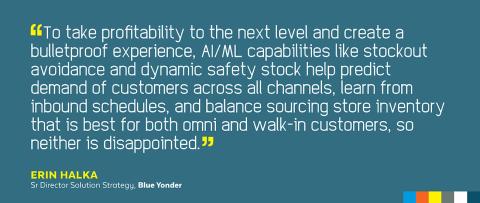Why Your Store Experience Isn’t Working

Retailers were forced to make quick technological advancements during the pandemic to cope with the influx of digital orders, but some of the choices made no longer support today’s customer-centric, shop anywhere model. Shoppers need flexible, real-time fulfillment options and a bad experience can leave them dissatisfied – and looking elsewhere to shop.
The need to create a unified customer experience across all touchpoints is strong, but the store experience is still faltering on this front, as retailers are still grasping for omnichannel proficiency.
RIS sits down with Blue Yonder’s Erin Halka, Sr Director Solution Strategy, to discuss the technologies stores need to create the optimum shopper experience and how artificial intelligence (AI) and machine learning (ML) can help.
RIS: Reflecting on the past two years of the COVID-19 pandemic, what have retailers learned and what are their biggest pain points today?
Erin Halka: During the early days of the pandemic, retailers quickly stood up new business processes and technology to help them address the sudden shift to move inventory out of the store to satisfy the spike in digital and omni fulfillment needs. Retailers didn’t have time to assess a field of solutions – they needed capabilities that could be turned on rapidly. Retailers learned how agile their teams could operate. Fast forward two years, many retailers are realizing those choices that worked well in the pandemic are now dragging down their profits. Stores picked up momentum and some of the omni decisions made when traffic was gone don’t support a flexible model where the customer will buy online today, shop in the store next week, and expect curbside in two hours the week after. Add inflation and labor shortage to the mix and cost to serve are dragging down profits.

RIS: How have customer expectations changed?
Halka: Customers are accustomed to free and fast shipping. They want flexible ways to get their items and to know their options in real-time while they are shopping – how much is available, when can I get it, and when do I need to place my order to hit my timeline. Companies providing these types of options see higher customer conversion than those that wait until the shopping cart to offer timeframes or notify a customer the items aren’t available. Customers also want visibility to the status once they hit purchase. Customers are highly sensitive to a bad experience – be it a delayed arrival, canceled item, or lack of convenient fulfillment options to get their items – and quickly find other retailers that will satisfy their needs. The ability to make the promise and keep the promise is the difference in creating customer loyalty vs. attrition.
RIS: What technologies do stores need to create the perfect omnichannel experience for the customer?
Halka: Retailers are realizing that for stores to perfect the omnichannel experience, they need to blend capabilities that work well in a warehouse into store operations, as well as systems that create a unified customer experience across all channels. This includes a streamlined receiving/outbound area in the back to efficiently move goods in and package them in time for their daily carrier pickup, with a growing number of companies considering RFID to rapidly check-in items. They need mobile tools that can help the associate find products to fulfill the omnichannel order – often including pictures and location in the store. And they need a convenient order pickup experience that helps associates know when the customer is on the way, at the store, and where their order will be. Returns have become part of the omnichannel experience, so the store needs a point of sale (POS) connected to all channels that makes it easy for the associate and the customer to complete quickly.

RIS: What role does AI/ML play in deploying an ironclad store experience?
Halka: Retailers have always leaned on the order management solution to solve the digital order but now a profitable omnichannel experience requires an agile order management solution (OMS) that helps rapidly onboard new strategies. The OMS needs to look across all channels to provide customers the information they want in near real-time, capabilities that are highly orchestrated to fulfill the order in rapid completion, all while considering a multitude of cost factors that make the most profitable decision. This has become almost table stakes. To take profitability to the next level and create an ironclad experience, AI/ML capabilities like stockout avoidance and dynamic safety stock help predict demand of customers across all channels, learn from inbound schedules, and balance sourcing store inventory that is best for both omni and walk-in customers, so neither is disappointed. Predicting the likelihood of an item being marked down and using it in fulfillment cost factors helps retailers make the most profitable sourcing decision for fulfillment, even when the store doesn’t seem to be the lowest cost initially.



